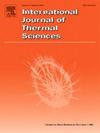Accurate estimation of interfacial thermal conductance between silicon and diamond enabled by a machine learning interatomic potential
IF 4.9
2区 工程技术
Q1 ENGINEERING, MECHANICAL
International Journal of Thermal Sciences
Pub Date : 2025-03-18
DOI:10.1016/j.ijthermalsci.2025.109876
引用次数: 0
Abstract
Thermal management at silicon-diamond interface is critical for advancing high-performance electronic and optoelectronic devices. In this study, we calculate the interfacial thermal conductance between silicon and diamond using a computationally efficient machine learning (ML) interatomic potential trained on density functional theory (DFT) data. Using non-equilibrium molecular dynamics (NEMD) simulations, we compute the interfacial thermal conductance (ITC) for various system sizes. Our results reveal an extremely close agreement with experimental data than those obtained using traditional semi-empirical potentials such as Tersoff and Brenner which overestimate ITC. In addition, we analyze the frequency-dependent heat transfer spectrum, providing insights into the contributions of different phonon modes to the interfacial thermal conductance. The ML potential accurately captures the phonon dispersion relations and lifetimes, in good agreement with DFT calculations and experimental observations. It is shown that the Tersoff potential predicts higher phonon group velocities and phonon lifetimes compared to the DFT results. Furthermore, it predicts higher interfacial bonding strength, which is consistent with higher interfacial thermal conductance as compared to the ML potential. This study highlights the use of ML interatomic potentials to improve the accuracy and computational efficiency of thermal transport simulations of complex material interface systems.

利用机器学习原子间势能准确估算硅与金刚石之间的界面热导率
硅-金刚石界面的热管理是推进高性能电子和光电子器件的关键。在这项研究中,我们使用密度泛函理论(DFT)数据训练的计算效率高的机器学习(ML)原子间势计算了硅和金刚石之间的界面导热系数。使用非平衡分子动力学(NEMD)模拟,我们计算了不同系统尺寸的界面热导(ITC)。我们的结果显示,与使用传统的半经验势(如Tersoff和Brenner)获得的数据相比,我们的结果与实验数据非常接近,后者高估了ITC。此外,我们分析了频率相关的传热谱,为不同声子模式对界面热导的贡献提供了见解。ML势准确地捕获了声子色散关系和寿命,与DFT计算和实验观察结果很好地吻合。结果表明,与DFT结果相比,Tersoff势预测了更高的声子群速度和声子寿命。此外,它预测了更高的界面结合强度,与ML电位相比,这与更高的界面热导一致。本研究强调使用ML原子间势来提高复杂材料界面系统热输运模拟的准确性和计算效率。
本文章由计算机程序翻译,如有差异,请以英文原文为准。
求助全文
约1分钟内获得全文
求助全文
来源期刊

International Journal of Thermal Sciences
工程技术-工程:机械
CiteScore
8.10
自引率
11.10%
发文量
531
审稿时长
55 days
期刊介绍:
The International Journal of Thermal Sciences is a journal devoted to the publication of fundamental studies on the physics of transfer processes in general, with an emphasis on thermal aspects and also applied research on various processes, energy systems and the environment. Articles are published in English and French, and are subject to peer review.
The fundamental subjects considered within the scope of the journal are:
* Heat and relevant mass transfer at all scales (nano, micro and macro) and in all types of material (heterogeneous, composites, biological,...) and fluid flow
* Forced, natural or mixed convection in reactive or non-reactive media
* Single or multi–phase fluid flow with or without phase change
* Near–and far–field radiative heat transfer
* Combined modes of heat transfer in complex systems (for example, plasmas, biological, geological,...)
* Multiscale modelling
The applied research topics include:
* Heat exchangers, heat pipes, cooling processes
* Transport phenomena taking place in industrial processes (chemical, food and agricultural, metallurgical, space and aeronautical, automobile industries)
* Nano–and micro–technology for energy, space, biosystems and devices
* Heat transport analysis in advanced systems
* Impact of energy–related processes on environment, and emerging energy systems
The study of thermophysical properties of materials and fluids, thermal measurement techniques, inverse methods, and the developments of experimental methods are within the scope of the International Journal of Thermal Sciences which also covers the modelling, and numerical methods applied to thermal transfer.
 求助内容:
求助内容: 应助结果提醒方式:
应助结果提醒方式:


